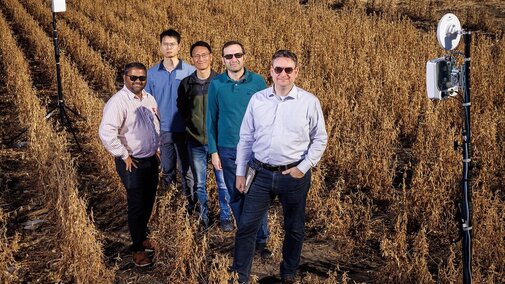Many farmers and agricultural experts see digital farming as the way of the future. Managing farms using sensors, drones and robots, artificial intelligence, advanced data analytics and more will be key to efficiently feeding the world’s increasing population, expected to reach 10 billion by 2050.
But maximizing agricultural technology’s potential hinges on a tool that most fields lack: high-speed internet connectivity.
An interdisciplinary Nebraska research team, led by computer engineer Mehmet Can Vuran, is trying to change that fact. The team includes Shuai Nie, Qiang Liu, Christos Argyropoulos, Yufeng Ge and Santosh Pitla. With a three-year, $1 million grant from the National Science Foundation, the team is designing a next-generation wireless network for agricultural fields that would catalyze an array of digital farming technologies and buoy the businesses of countless farmers. Currently, at least two-thirds of farmers say they lack sufficient internet connectivity to run their operations, and 25% of U.S. farms do not have internet at all.
“We have started to redesign the wireless network according to the constraints and requirements of agricultural fields,” said Vuran, Jensen Chair and professor of computing. “Right now, the best farmers and researchers can do is grab wireless technologies from whatever is available in nearby urban environments. They try to use Wi-Fi or existing cellular connections, which were not designed for the field. This is like trying to fit a square peg into a round hole.”
It’s a mismatch because the two environments are vastly different. Urban connectivity leverages the vertical infrastructure inherent to cities: tall buildings, streetlights and traffic lights house the necessary equipment. Agricultural fields lack this robust vertical infrastructure, making it much more difficult to build a network.
Additionally, agricultural fields are subjected to harsh environmental and weather conditions that can interrupt wireless connections. The type of crop, its stage of growth and even a plant’s moisture content can also affect signals. Vuran’s group is devising a wireless architecture called Field-Nets to address these challenges.
A cornerstone of their approach is deployment of millimeter wave technology on farms. This technology, increasingly used to support 5G connections in urban areas, sends signals on a bandwidth of the radio-frequency spectrum that is not overcrowded. Plentiful bandwidth means signal transmission is fast, at gigabits per second, with minimal disruption.
To read more about this project, visit Nebraska Today.

